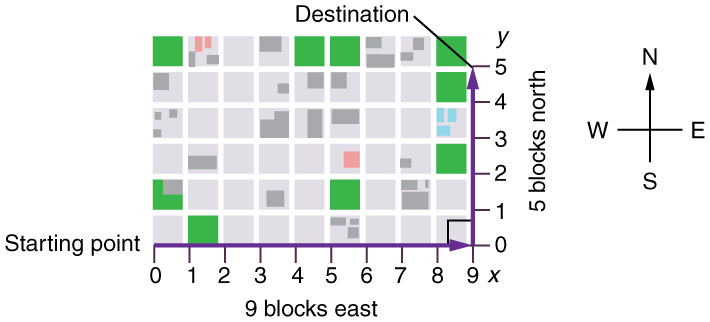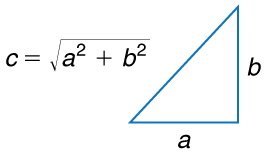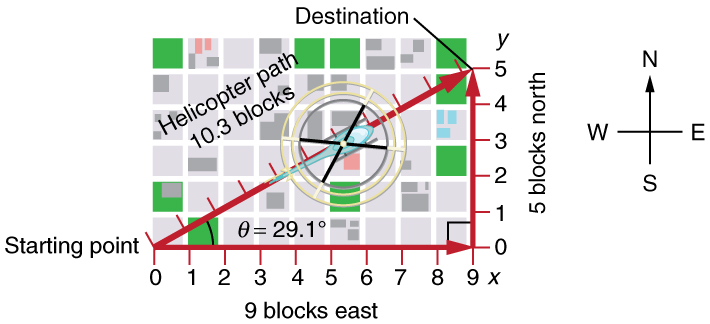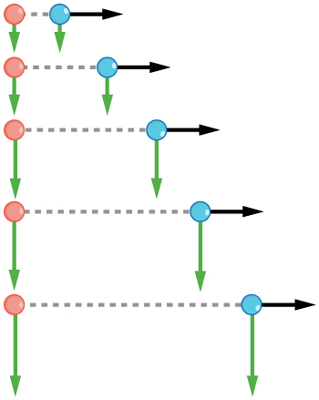Kinematics
17 Kinematics in Two Dimensions: An Introduction
Learning Objectives
-
Observe that motion in two dimensions consists of horizontal and vertical components.
-
Understand the independence of horizontal and vertical vectors in two-dimensional motion.

Two-Dimensional Motion: Walking in a City
Suppose you want to walk from one point to another in a city with uniform square blocks, as pictured in Figure 17.2.

The straight-line path a helicopter might fly is blocked to you as a pedestrian, so you must take a two-dimensional path, such as the one shown: 9 blocks east followed by 5 blocks north, totaling 14 blocks walked.
What is the straight-line distance between your start and end points?
An old adage states that the shortest distance between two points is a straight line. Because the two legs of the trip and the straight-line path form a right triangle, the Pythagorean theorem applies:
[latex]{a}^{2} + {b}^{2} = {c}^{2}[/latex]
where [latex]a[/latex] and [latex]b[/latex] are the legs of the triangle, and [latex]c[/latex] is the hypotenuse (the straight-line distance).

Calculating the straight-line distance:
[latex]c = \sqrt{(9\ \text{blocks})^{2} + (5\ \text{blocks})^{2}} = \sqrt{81 + 25} = \sqrt{106} = 10.3\ \text{blocks}[/latex]
This distance is considerably shorter than the 14 blocks you walked.

Vectors and Components
The straight-line distance (magnitude of displacement) being less than the total distance walked exemplifies a general property of vectors—quantities with both magnitude and direction.
In two-dimensional motion, vectors are represented by arrows whose lengths correspond to their magnitudes and point in their directions.
The path of the pedestrian in Figure 17.4 can be represented by three vectors:
-
A 9-block displacement east (horizontal component)
-
A 5-block displacement north (vertical component)
-
The straight-line displacement (resultant vector, 10.3 blocks)
These perpendicular components add vectorially to produce the resultant displacement. The Pythagorean theorem applies only because the components are perpendicular.
The Independence of Perpendicular Motions
The pedestrian’s motion east and north are independent: motion in one direction does not affect motion in the other.
This principle extends to motions where horizontal and vertical components occur simultaneously.
For example, two identical baseballs:
-
One dropped from rest
-
One thrown horizontally from the same height

The balls’ vertical positions at equal time intervals are the same, proving vertical motion depends only on gravity (ignoring air resistance). The ball thrown horizontally has constant horizontal velocity, unaffected by vertical motion.
PhET Explorations: Ladybug Motion 2D
Learn about position, velocity and acceleration vectors. Move the ladybug by setting the position, velocity or acceleration, and see how the vectors change. Choose linear, circular or elliptical motion, and record and playback the motion to analyze the behavior.
Summary
-
Two-dimensional motion can be broken into independent horizontal and vertical components.
-
The Pythagorean theorem applies to find resultant displacement when components are perpendicular.
-
Independence of perpendicular motions allows analyzing complex trajectories like projectile motion by considering each component separately.
Glossary
- vector
- a quantity that has both magnitude and direction; an arrow used to represent quantities with both magnitude and direction
A quantity that is described by both magnitude and direction

